Page 242 of 436
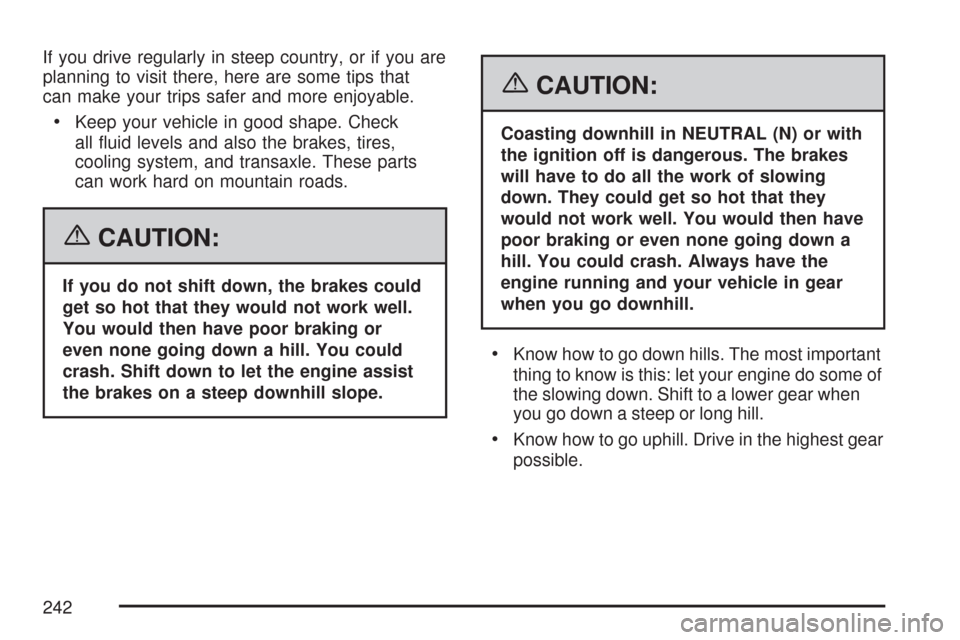
If you drive regularly in steep country, or if you are
planning to visit there, here are some tips that
can make your trips safer and more enjoyable.
•Keep your vehicle in good shape. Check
all fluid levels and also the brakes, tires,
cooling system, and transaxle. These parts
can work hard on mountain roads.
{CAUTION:
If you do not shift down, the brakes could
get so hot that they would not work well.
You would then have poor braking or
even none going down a hill. You could
crash. Shift down to let the engine assist
the brakes on a steep downhill slope.
{CAUTION:
Coasting downhill in NEUTRAL (N) or with
the ignition off is dangerous. The brakes
will have to do all the work of slowing
down. They could get so hot that they
would not work well. You would then have
poor braking or even none going down a
hill. You could crash. Always have the
engine running and your vehicle in gear
when you go downhill.
•Know how to go down hills. The most important
thing to know is this: let your engine do some of
the slowing down. Shift to a lower gear when
you go down a steep or long hill.
•Know how to go uphill. Drive in the highest gear
possible.
242
Page 246 of 436
If You Are Caught in a Blizzard
If you are stopped by heavy snow, you could be in
a serious situation. You should probably stay
with your vehicle unless you know for sure that you
are near help and you can hike through the
snow. Here are some things to do to summon
help and keep yourself and your passengers safe:
•Turn on your hazard flashers.
•Tie a red cloth to your vehicle to alert police
that you have been stopped by the snow.
•Put on extra clothing or wrap a blanket around
you. If you do not have blankets or extra
clothing, make body insulators from
newspapers, burlap bags, rags, floor
mats — anything you can wrap around yourself
or tuck under your clothing to keep warm.You can run the engine to keep warm, but be
careful.
246
Page 247 of 436
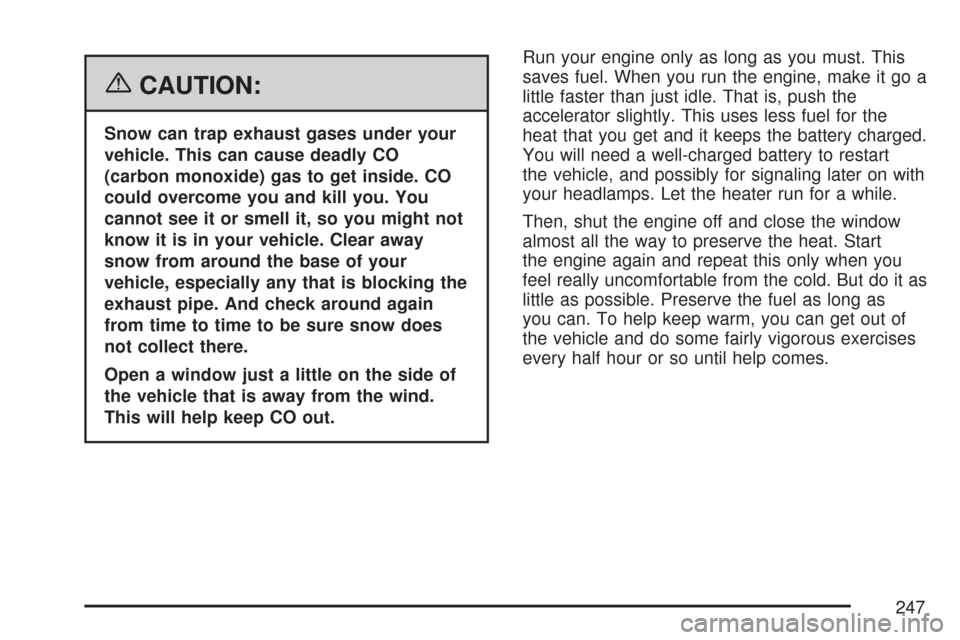
{CAUTION:
Snow can trap exhaust gases under your
vehicle. This can cause deadly CO
(carbon monoxide) gas to get inside. CO
could overcome you and kill you. You
cannot see it or smell it, so you might not
know it is in your vehicle. Clear away
snow from around the base of your
vehicle, especially any that is blocking the
exhaust pipe. And check around again
from time to time to be sure snow does
not collect there.
Open a window just a little on the side of
the vehicle that is away from the wind.
This will help keep CO out.Run your engine only as long as you must. This
saves fuel. When you run the engine, make it go a
little faster than just idle. That is, push the
accelerator slightly. This uses less fuel for the
heat that you get and it keeps the battery charged.
You will need a well-charged battery to restart
the vehicle, and possibly for signaling later on with
your headlamps. Let the heater run for a while.
Then, shut the engine off and close the window
almost all the way to preserve the heat. Start
the engine again and repeat this only when you
feel really uncomfortable from the cold. But do it as
little as possible. Preserve the fuel as long as
you can. To help keep warm, you can get out of
the vehicle and do some fairly vigorous exercises
every half hour or so until help comes.
247
Page 248 of 436
If Your Vehicle is Stuck in Sand,
Mud, Ice, or Snow
In order to free your vehicle when it is stuck, you
will need to spin the wheels, but you do not
want to spin your wheels too fast. The method
known as rocking can help you get out when you
are stuck, but you must use caution.
{CAUTION:
If you let your vehicle’s tires spin at high
speed, they can explode, and you or
others could be injured. And, the
transaxle or other parts of the vehicle can
overheat. That could cause an engine
compartment �re or other damage. When
you are stuck, spin the wheels as little as
possible. Do not spin the wheels above
35 mph (55 km/h) as shown on the
speedometer.
Notice:Spinning the wheels can destroy parts
of your vehicle as well as the tires. If you
spin the wheels too fast while shifting
the transaxle back and forth, you can destroy
the transaxle. SeeRocking Your Vehicle to
Get It Out on page 249.
For information about using tire chains on your
vehicle, seeTire Chains on page 335.
248
Page 261 of 436

Service........................................................ 264
Accessories and Modifications................... 264
California Proposition 65 Warning.............. 265
Doing Your Own Service Work.................. 265
Adding Equipment to the Outside of
Your Vehicle.......................................... 266
Fuel............................................................. 266
Gasoline Octane........................................ 266
Gasoline Specifications.............................. 266
California Fuel........................................... 267
Additives................................................... 267
Fuels in Foreign Countries........................ 268
Filling the Tank......................................... 269
Filling a Portable Fuel Container............... 272
Checking Things Under the Hood.............. 273
Hood Release........................................... 274
Engine Compartment Overview.................. 276
Engine Oil................................................. 277
Engine Air Cleaner/Filter............................ 281
Automatic Transaxle Fluid......................... 283Manual Transaxle Fluid............................. 285
Hydraulic Clutch........................................ 286
Engine Coolant.......................................... 287
Coolant Surge Tank Pressure Cap............ 290
Engine Overheating................................... 290
Cooling System......................................... 292
Power Steering Fluid................................. 297
Windshield Washer Fluid........................... 298
Brakes...................................................... 299
Battery...................................................... 303
Jump Starting............................................ 304
Headlamp Aiming........................................ 309
Bulb Replacement....................................... 309
Halogen Bulbs........................................... 309
Headlamps (Hatchback)............................. 310
Headlamps (Sedan)................................... 311
Front Turn Signal and Parking Lamps
(Hatchback)............................................ 312
Front Turn Signal and Parking Lamps
(Sedan).................................................. 313
Section 5 Service and Appearance Care
261
Page 263 of 436
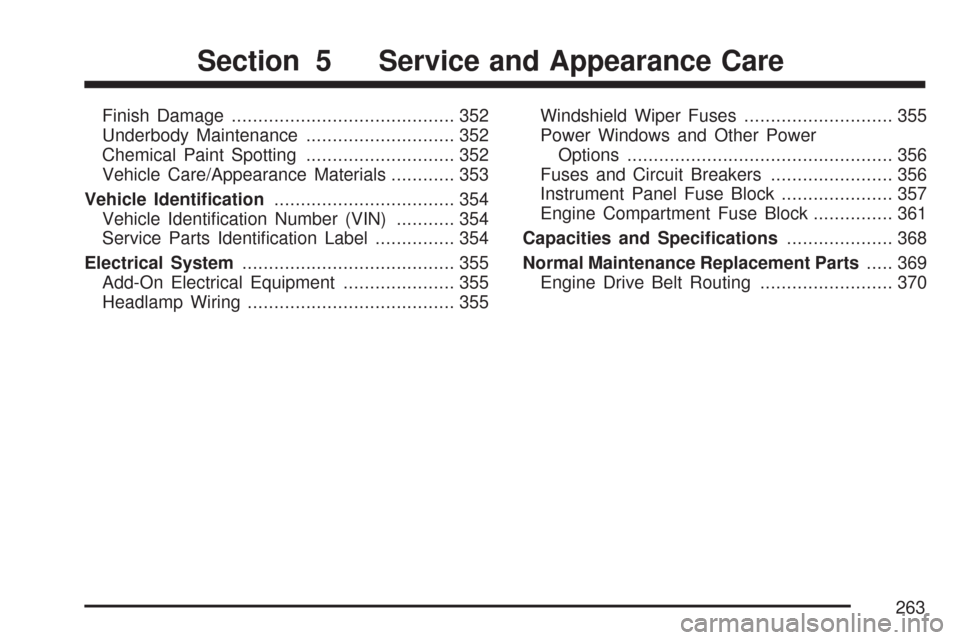
Finish Damage.......................................... 352
Underbody Maintenance............................ 352
Chemical Paint Spotting............................ 352
Vehicle Care/Appearance Materials............ 353
Vehicle Identi�cation.................................. 354
Vehicle Identification Number (VIN)........... 354
Service Parts Identification Label............... 354
Electrical System........................................ 355
Add-On Electrical Equipment..................... 355
Headlamp Wiring....................................... 355Windshield Wiper Fuses............................ 355
Power Windows and Other Power
Options.................................................. 356
Fuses and Circuit Breakers....................... 356
Instrument Panel Fuse Block..................... 357
Engine Compartment Fuse Block............... 361
Capacities and Speci�cations.................... 368
Normal Maintenance Replacement Parts..... 369
Engine Drive Belt Routing......................... 370
Section 5 Service and Appearance Care
263
Page 265 of 436
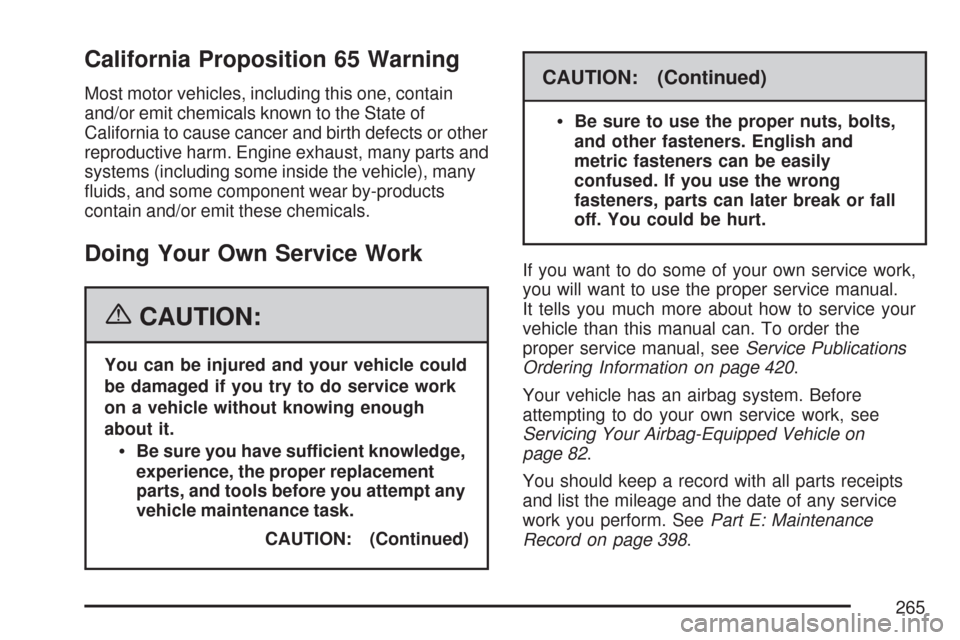
California Proposition 65 Warning
Most motor vehicles, including this one, contain
and/or emit chemicals known to the State of
California to cause cancer and birth defects or other
reproductive harm. Engine exhaust, many parts and
systems (including some inside the vehicle), many
fluids, and some component wear by-products
contain and/or emit these chemicals.
Doing Your Own Service Work
{CAUTION:
You can be injured and your vehicle could
be damaged if you try to do service work
on a vehicle without knowing enough
about it.
Be sure you have sufficient knowledge,
experience, the proper replacement
parts, and tools before you attempt any
vehicle maintenance task.
CAUTION: (Continued)
CAUTION: (Continued)
Be sure to use the proper nuts, bolts,
and other fasteners. English and
metric fasteners can be easily
confused. If you use the wrong
fasteners, parts can later break or fall
off. You could be hurt.
If you want to do some of your own service work,
you will want to use the proper service manual.
It tells you much more about how to service your
vehicle than this manual can. To order the
proper service manual, seeService Publications
Ordering Information on page 420.
Your vehicle has an airbag system. Before
attempting to do your own service work, see
Servicing Your Airbag-Equipped Vehicle on
page 82.
You should keep a record with all parts receipts
and list the mileage and the date of any service
work you perform. SeePart E: Maintenance
Record on page 398.
265
Page 266 of 436
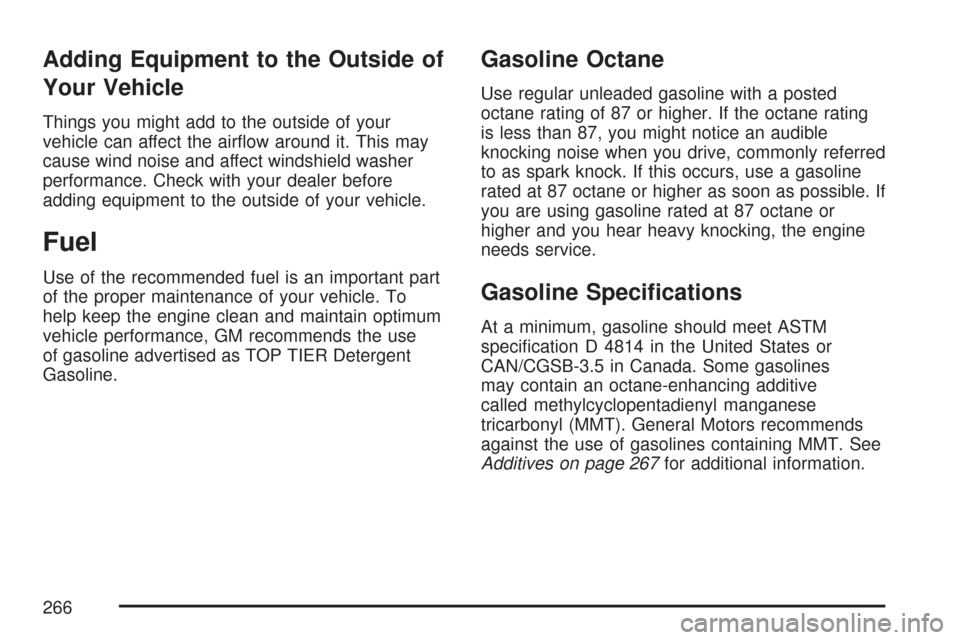
Adding Equipment to the Outside of
Your Vehicle
Things you might add to the outside of your
vehicle can affect the airflow around it. This may
cause wind noise and affect windshield washer
performance. Check with your dealer before
adding equipment to the outside of your vehicle.
Fuel
Use of the recommended fuel is an important part
of the proper maintenance of your vehicle. To
help keep the engine clean and maintain optimum
vehicle performance, GM recommends the use
of gasoline advertised as TOP TIER Detergent
Gasoline.
Gasoline Octane
Use regular unleaded gasoline with a posted
octane rating of 87 or higher. If the octane rating
is less than 87, you might notice an audible
knocking noise when you drive, commonly referred
to as spark knock. If this occurs, use a gasoline
rated at 87 octane or higher as soon as possible. If
you are using gasoline rated at 87 octane or
higher and you hear heavy knocking, the engine
needs service.
Gasoline Speci�cations
At a minimum, gasoline should meet ASTM
specification D 4814 in the United States or
CAN/CGSB-3.5 in Canada. Some gasolines
may contain an octane-enhancing additive
called methylcyclopentadienyl manganese
tricarbonyl (MMT). General Motors recommends
against the use of gasolines containing MMT. See
Additives on page 267for additional information.
266